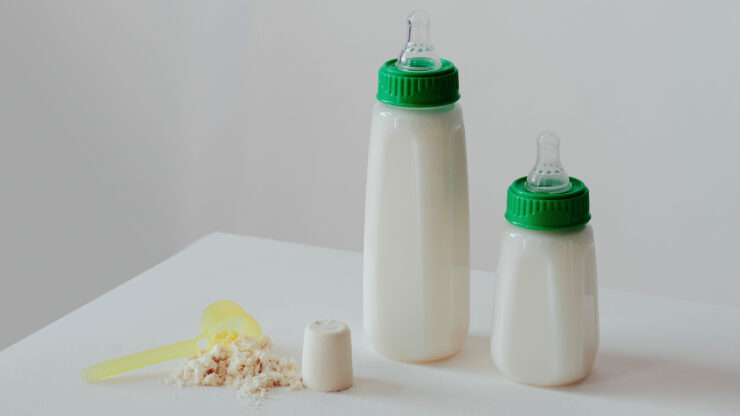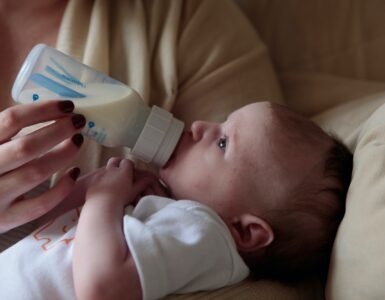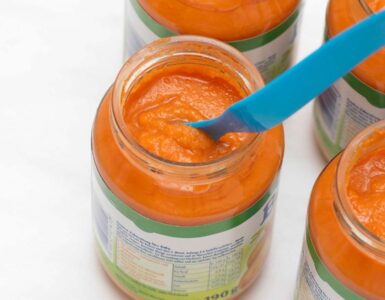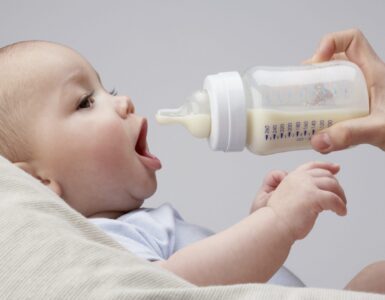Breast milk is the best food for most babies and should be kept as long as possible. But it is not always possible for mothers to provide breast milk to their babies. This can be due to all kinds of illnesses of the breastfeeding woman, the treatment of which is incompatible with breastfeeding. There are situations where milk disappears on its own, or for some individual beliefs or psychological reasons mothers do not want to breastfeed their baby with their milk. In addition, sometimes the baby needs a therapeutic formula to solve a specific problem, in which case a special milk formula replaces or supplements breastfeeding completely.
The advice of a doctor is very important

Before deciding which formula to choose, you should ask your pediatrician for advice on what to pay attention to in each situation. Which formula has what content and proportion of proteins, fats, and carbohydrates – if, for instance, the child is underweight or underweight, it should be given a more nutritious and easily digestible formula. The doctor will point out certain components of the formula if the child is prone to food allergies. If the baby is in good health, gaining weight, and does not suffer from allergies or digestive disorders, it is possible to choose a milk formula based on the age of the baby (this information is always written on the package of milk formula).
Let’s look at when it is necessary to switch from breastfeeding to the formula:
- Individual intolerance, e.g. some children are allergic to the components contained in mother’s milk
- The baby is not gaining weight well and it is necessary to supplement with formula therefore consider switching completely to formula, using a highly adaptable, highly digestible formula with a more nutritious composition
- If the mother stops lactating for any reason
- The mother’s individual beliefs or psychological reasons for not wanting to breastfeed
Which baby formula is closest to breast milk?

The most highly adapted and adapted to breast milk, they are of the highest quality and contain almost all the elements necessary for the health of the baby. These formulas contain whey proteins and casein, lecithin, and taurine. The preferred components of the milk formula are also:
Omega 3 and Omega 6 fatty acids (which can occur as linoleic and α-linolenic acids) – ensure the healthy development of the brain and all other organs as well as visual acuity.
Maltodextrin – regulates the rate of absorption of formula, and continues the feeling of satiety and energy supply – so you can slightly increase the interval between feedings for your baby.
Probiotics – microorganisms that form the correct microflora of the baby’s gut. Bifidobacteria are particularly important for babies, as these are the first to inhabit the baby’s intestines and to prevent colic.
Prebiotics (oligosaccharides) – components that are processed by the microflora of the lower intestine, support its growth and vitality.
Nucleotides – components of nucleic acids (DNA, RNA), controlling the processes of reproduction, development, and metabolism, and contained in every cell of the living organism.
L-carnitine or “growth vitamin” is involved in metabolism as a carrier of fatty acids into the mitochondria, where fat is converted into energy “fuel” for the body.
Choline is one of the B vitamins and participates in the development of the nervous system, and it is also a good hepatoprotection.
Baby food should be bought from specialist shops or pharmacies. Online shopping is also a good option. For example, the Organic baby formula shop has a huge range of quality milk formulas at an affordable prices.
How to make a smooth transition from breastfeeding to formula?
Ideally, the formula should be introduced gradually. In total, the transition takes between 5 days and 2 weeks. On the first day, artificial feeding should take up half of the feeding norms. If the mother has milk and the baby accepts it well, it is a good idea to start feeding from this and then supplement it with formula. If there is no milk or the baby cannot tolerate it, the second half of the feeding should be vegetable, fruit, or rosehip infusions.
On the second day, the amount of formula in the feed ratio should be increased to at least 2/3 of the total amount. If the baby absorbs the formula well and there is no frequent regurgitation, constipation, or diarrhea, on the fifth day it is possible to switch completely to artificial feeding.
If the baby is already eating complementary foods, formula feeding is alternated with it.
The general algorithm for the transition from breastfeeding to formula feeding is the same for a baby in the first month of life as it is for a six-month-old baby.
What to look out for when choosing a formula?

It is important to understand that with the introduction of a new formula a gradual adaptation (about 3-6 days) is necessary. It is not necessary to “jump” from one formula to another every 2-3 days. The amount of new formula in each feeding should be increased every day and the amount of the previous formula decreased.
Each formula is designed for the needs of the baby and contains all the substances necessary for the harmonious growth and development of the child. As your baby gets older, the formula becomes more nutritious, the protein composition changes, and the number of important minerals and trace elements, especially calcium and iron, increases.
Organic milk formula must contain vitamins and minerals, prebiotics, and oligosaccharides to support a digestive system.
As a rule of thumb, it is advisable to keep open containers of formula for 2-3 weeks. Also, pay attention to the expiry date when you buy it.
Infant feeding regime
In contrast to natural breastfeeding, where the baby is brought to the breast on very short notice, feeding formula on an artificial feeding schedule is better to avoid overfeeding. This can lead to metabolic disorders, obesity, and diabetes mellitus. The intervals between feedings should be at least 3 hours, even for a very small baby.
It is important to plan the child’s sleep and activity, e.g. so that the feeding does not take place in the middle of a daytime nap or so that the child does not have to be woken up to eat, or wake up early from hunger.
Every child is unique and their nutritional needs may change from day to day. Never force-feed or leave your baby hungry. If your baby mumps, he is not full. If your baby burps occasionally, it may be better to feed him more often and in smaller portions.
For hygienic reasons, the ready-made formula should always be given immediately. Cooked formula left over after feeding should not be stored and used in the future. If your baby does not swallow the contents of the bottle, the fresh formula must be prepared for the next feeding.
Milk formula is a source of enormous amounts of nutrients and has a relatively high caloric intake. So it is not a drink that can be eaten up to five times a day. Taking formula is equivalent to eating it. And, for example, a child of two years old can be given formula for an afternoon snack. In this case, it is adequate and adapted to the age of the child and he or she will only benefit from it.
What temperature should the water be when preparing the formula?
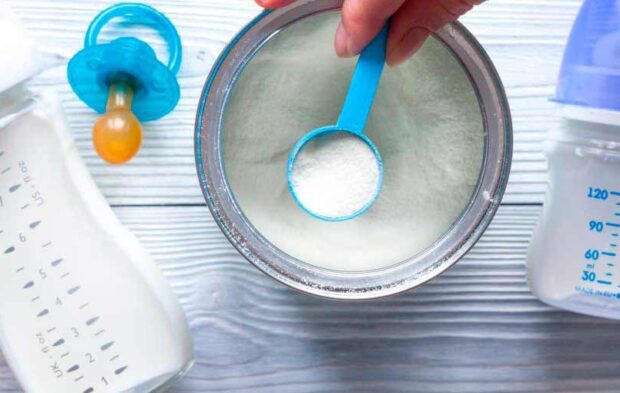
You should use drinking water that has been boiled for 10 minutes and cooled to 40 °C to prepare baby formula. Why is it important to cool to this temperature? To preserve the vitamins and live essential microbes in the finished formula. It is only after cooling to 40°C that the dry mixture can be added. It is also advisable not to shake the bottle vigorously when stirring it. To avoid the baby getting colic, we recommend stirring the bottle with the formula with gentle movements of the hand.
How do I know if the formula is not suitable?
Of course, not all formulas may be suitable for your baby, and it is not about milk substitutes, but about your baby’s individual body’s reaction to them. So if the baby likes the new food, is eating with pleasure and steadily gaining weight, has no regurgitation or stool problems, and no skin rashes – this means that all is well and it is the same formula.
And if the baby is crying, has frequent regurgitation, diarrhea, bloating, skin allergies, swelling, and is not gaining weight – it means that the formula is not suitable and it is necessary to contact the pediatrician to determine together which formula will meet the child’s needs.
When feeding your baby you should monitor his/her condition and at the first signs of alarm, such as skin reactions or bloating, contact your pediatrician who will help you find a different formula.

